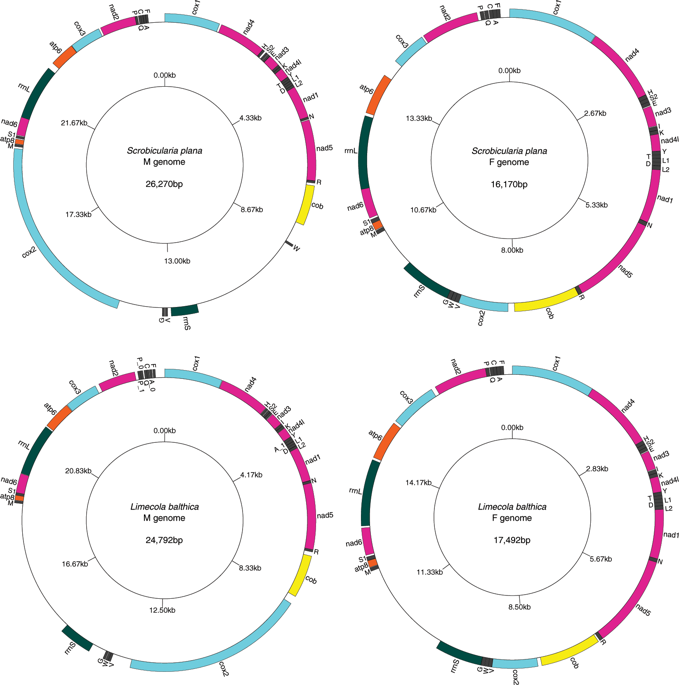Our official English website, www.x-mol.net, welcomes your
feedback! (Note: you will need to create a separate account there.)
Unorthodox features in two venerid bivalves with doubly uniparental inheritance of mitochondria.
Scientific Reports ( IF 3.8 ) Pub Date : 2020-01-23 , DOI: 10.1038/s41598-020-57975-y Charlotte Capt 1 , Karim Bouvet 1 , Davide Guerra 1 , Brent M Robicheau 2 , Donald T Stewart 3 , Eric Pante 4 , Sophie Breton 1
Scientific Reports ( IF 3.8 ) Pub Date : 2020-01-23 , DOI: 10.1038/s41598-020-57975-y Charlotte Capt 1 , Karim Bouvet 1 , Davide Guerra 1 , Brent M Robicheau 2 , Donald T Stewart 3 , Eric Pante 4 , Sophie Breton 1
Affiliation

|
In animals, strictly maternal inheritance (SMI) of mitochondria is the rule, but one exception (doubly uniparental inheritance or DUI), marked by the transmission of sex-specific mitogenomes, has been reported in bivalves. Associated with DUI is a frequent modification of the mitochondrial cox2 gene, as well as additional sex-specific mitochondrial genes not involved in oxidative phosphorylation. With the exception of freshwater mussels (for 3 families of the order Unionida), these DUI-associated features have only been shown in few species [within Mytilidae (order Mytilida) and Veneridae (order Venerida)] because of the few complete sex-specific mitogenomes published for these orders. Here, we present the complete sex-specific mtDNAs of two recently-discovered DUI species in two families of the order Venerida, Scrobicularia plana (Semelidae) and Limecola balthica (Tellinidae). These species display the largest differences in genome size between sex-specific mitotypes in DUI species (>10 kb), as well as the highest mtDNA divergences (sometimes reaching >50%). An important in-frame insertion (>3.5 kb) in the male cox2 gene is partly responsible for the differences in genome size. The S. plana cox2 gene is the largest reported so far in the Kingdom Animalia. The mitogenomes may be carrying sex-specific genes, indicating that general mitochondrial features are shared among DUI species.
中文翻译:

两种具有线粒体双单亲遗传的双壳类动物的非正统特征。
在动物中,线粒体的严格母系遗传(SMI)是规则,但在双壳类动物中报道了一个例外(双单亲遗传或 DUI),其特征是性别特异性线粒体基因组的传递。与 DUI 相关的是线粒体 cox2 基因的频繁修饰,以及不参与氧化磷酸化的其他性别特异性线粒体基因。除淡水贻贝(Unionida 目 3 个科)外,这些与酒后驾车相关的特征仅在少数物种中显示[在 Mytilidae(Mytilida 目)和 Veneridae(Veneridae)内],因为很少有完全性别特异性的贻贝。为这些命令发布了线粒体基因组。在这里,我们展示了最近发现的两种酒后驾车物种的完整性别特异性 mtDNA,这两个物种属于 Venerida 目、Scrobillary plana (Semelidae) 和 Limecola balthica (Tellinidae) 两个科。这些物种在 DUI 物种中性别特异性有丝分裂型之间的基因组大小差异最大(>10 kb),并且 mtDNA 差异最大(有时达到 >50%)。雄性 cox2 基因中重要的框内插入 (>3.5 kb) 是造成基因组大小差异的部分原因。 S. plana cox2 基因是动物界迄今为止报道的最大基因。线粒体基因组可能携带性别特异性基因,表明酒后驾车物种之间具有共同的线粒体特征。
更新日期:2020-01-23
中文翻译:

两种具有线粒体双单亲遗传的双壳类动物的非正统特征。
在动物中,线粒体的严格母系遗传(SMI)是规则,但在双壳类动物中报道了一个例外(双单亲遗传或 DUI),其特征是性别特异性线粒体基因组的传递。与 DUI 相关的是线粒体 cox2 基因的频繁修饰,以及不参与氧化磷酸化的其他性别特异性线粒体基因。除淡水贻贝(Unionida 目 3 个科)外,这些与酒后驾车相关的特征仅在少数物种中显示[在 Mytilidae(Mytilida 目)和 Veneridae(Veneridae)内],因为很少有完全性别特异性的贻贝。为这些命令发布了线粒体基因组。在这里,我们展示了最近发现的两种酒后驾车物种的完整性别特异性 mtDNA,这两个物种属于 Venerida 目、Scrobillary plana (Semelidae) 和 Limecola balthica (Tellinidae) 两个科。这些物种在 DUI 物种中性别特异性有丝分裂型之间的基因组大小差异最大(>10 kb),并且 mtDNA 差异最大(有时达到 >50%)。雄性 cox2 基因中重要的框内插入 (>3.5 kb) 是造成基因组大小差异的部分原因。 S. plana cox2 基因是动物界迄今为止报道的最大基因。线粒体基因组可能携带性别特异性基因,表明酒后驾车物种之间具有共同的线粒体特征。















































 京公网安备 11010802027423号
京公网安备 11010802027423号